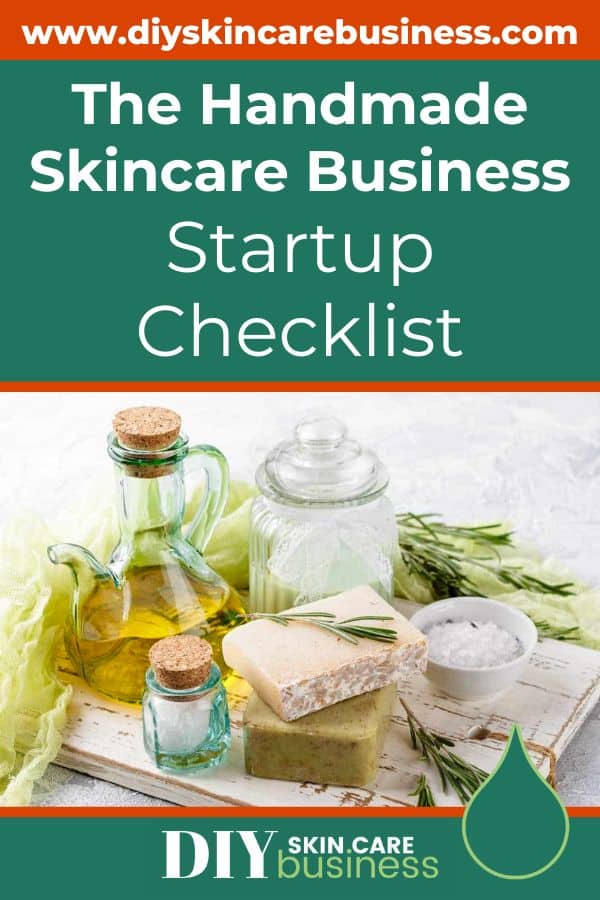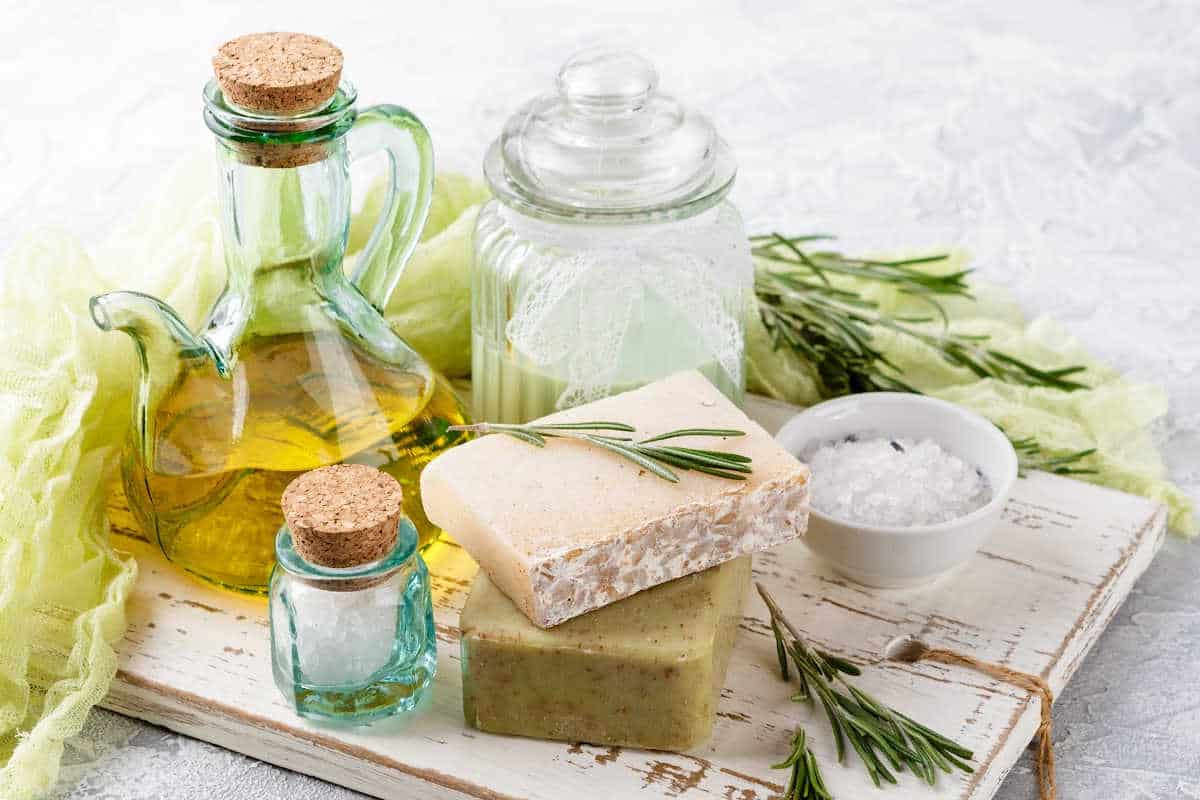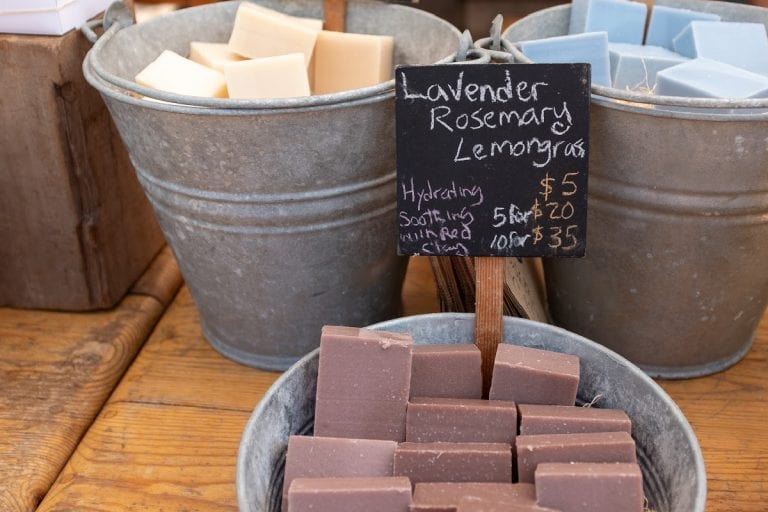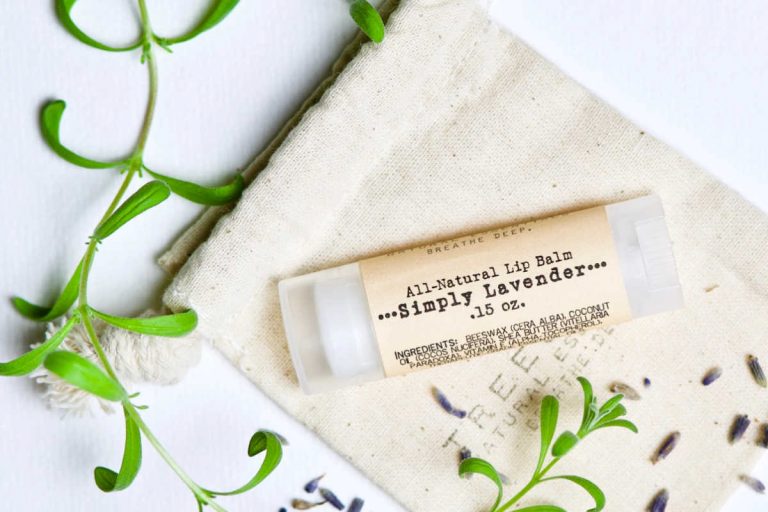Pull up a chair and get ready to scroll through THE ultimate business startup checklist for handmade skincare entrepreneurs!
If you are on a mission to make skin care products from your own home and sell them via e-commerce, you’re in the right spot – this list will guide you through each and every detail: business mission to market research to publishing your website.
The most streamlined way to get your skin care business up and running ASAP!
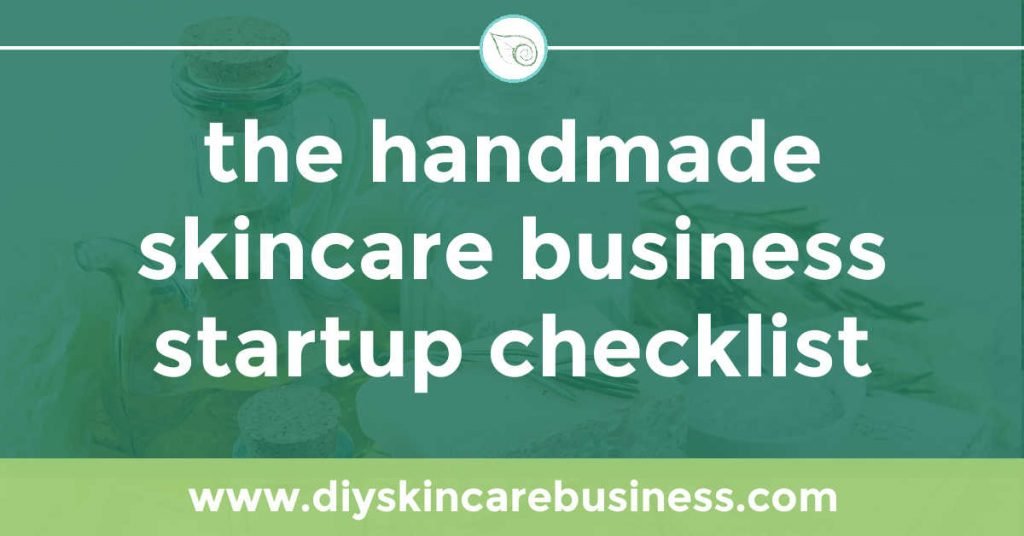
This post may contain affiliate links, meaning I get a commission if you decide to make a purchase through my links (at no cost to you). Please read the disclosure for more information.
Don’t need the whole list? Click below to skip ahead:
| 1. Initial Business Setup | 2. Choosing Recipes |
| 3. Visual Branding | 4. Ecommerce Sites |
| 5. Financials | 6. Go Live! |
Initial Skincare Business Setup
1. Business mission
Your business mission – your ‘WHY’ – is going to define every step you make as an entrepreneur.
Take the time to soul search. Dig deep. Of course you want to sell handmade skincare products and make an income doing it – but what kind of experience do you want to provide? How do you want to be perceived?
This statement is just for you. You’re not a huge corporation that needs to post this on your site (unless you want to!). Don’t get caught up in the details of having ‘fancy’ language or the ‘right’ number of sentences. Keep it straight and simple.
Write down your mission statement and use it as your guiding light for every step in this list.
Additional resources and reading:
2. Target Market
If you try to sell to EVERYONE, you will sell to NO ONE.
We live in a time where we get to (and NEED to) choose very specifically who we want to cater to.
This means rolling up your sleeves and pinpointing the demographics, psychographics, and fleshing out a customer avatar for your unique skin care business.
Do NOT skip this important step – and have FUN with it (you are making your dream business come to life!).
Your color palette, font choices, packaging choices, and marketing platforms will all depend on this background work.
Additional resources and reading:
3. Name Your Skin Care Business
The name of your skin care business creates a ‘first impression’ for your customer.
Your business name will be the anchor of your website, social media handles, and email address – take the time to choose a name that represents your mission and target market!
Be sure to read the first article below for tips, strategies, and examples for naming your skin care business that will stand the test of time.
Additional resources and reading:
- Naming Your Skin Care Business (for Longevity)
- GoDaddy (see if the name is even available before falling in love!)
4. Create an LLC (optional)
An LLC is a business structure that separates you as the business owner from your actual business.
This allows your personal assets to be protected and also allows for other ‘entrepreneur things’, such as getting a business bank account and funding.
Spoiler alert: Having an LLC is not required to ‘open’ a skin care business.
But the need for liability protection as a skin care maker is much higher than a jewelry maker or potter. Take seven minutes to read why in the additional resources below.
5. Get Your EIN
An EIN is basically a social security number for your skin care business.
You’ll need this to open most business bank accounts (and to hire employees if that’s in your future).
Additional reading:
6. Open a Business Bank Account
We’re lucky ducks to be in a time where small business bank accounts can be free – a luxury compared to how it used to be!
When choosing a bank, make sure you understand if there are minimum balance requirements, transaction fees, and easy access (online banking, ATMs nearby, etc).
The recommendations below by Nerdwallet are just to get your feet wet with questions to ask and features to check for in a financial institution for your skin care business – be sure to search for local spots that offer community perks as well.
Additional reading:
- 13 Best Free Business Checking Accounts (by nerdwallet)
- 6 Best Credit Unions (also by nerdwallet)
Choosing Your Skin Care Recipes
7. Market Research for Your Skincare Business
I’m sure you’re thinking, ‘Why does this checklist start with target markets and bank accounts BEFORE even diving into the topic of skin care recipes???’
And that is because I made two assumptions:
- You’re here to build a business, not a hobby.
- You have made skin care products before and know the basics, which is how you know you WANT to turn that passion into a business.
As a business owner, you need to create what your target market actually wants to BUY, not what you want to MAKE (which is where most handmade entrepreneurs go wrong).
Choose the products for your future line by doing some basic market research on Etsy and Google – dig around and see what your ideal customer is searching for.
Read the ‘Create a Converting Skin Care Product List’ below and have fun entering your product ideas in Google Trends to see if they’re winners!
Additional resources and reading:
8. Purchase Supplies and Ingredients
One of the perks of handmade skin care is that a lot of supplies and ingredients are already hiding in your cabinets…if you’re making products for yourself.
Now that you’re going to be an entrepreneur, you absolutely need a separate set of supplies and ingredients that are dedicated JUST to your business.
Most obviously because this omits the possibility of cross-contamination between skin care ingredients and food.
But this is also logistically necessary for tax purposes, such as deductions and end-of-year inventory for your Schedule C…but more on that further down on the list.
Time to stock up using the links below (and save those receipts for tax time)!
Additional resources and vendors:
- DIY Skin Care Ingredients and Supplies
- Plant Therapy (essential oils and carrier oils)
- Starwest Botanicals (they have larger quantities of ingredients at great prices)
9. Master Your Skin Care Formulations
Before deciding on your final product list, take the time to practice making all of your intended recipes on repeat.
Your customers will expect consistency across the board, and you want to make sure that you can batch-create while keeping top-notch quality.
You also want to make sure that the skin care products you make are worth your time (time is money, especially as a maker!).
If making that cold process soap or filling teeny tiny tubes is taking so long that it puts you below minimum wage, it’s time to move on to a more profitable product idea.
There are so many fantastic retail-worthy DIY skin care recipes out there – find the ones that work with your unique skill set!
Additional resources and reading:
10. Get Product Feedback
The last key to determining your final FINAL product list is feedback from individuals that represent the target market of your skin care business.
Yes, it’s okay to get the opinion of family and friends – just make sure that if your ideal customer is a new mother in her mid-30s that you’re not getting the opinion of a younger individual with no childbearing experience.
(There’s no way they would understand the skincare needs of that postpartum mama!)
Sidenote: The timing of feedback can be a tricky thing. Obviously you want to know if your products are well-received before purchasing containers, labels, etc. for that particular item...
However, these details are also part of the overall experience. Getting feedback throughout the entire making/branding process is always the best bet. The branding details included in the questions below will be discussed in the next section of our list.
Questions to consider asking your feedback volunteers:
- Does this product do what it says it will do in the product description?
- Please note your experience with the product, including notes about the scent and consistency.
- Does the container and label hold up well after continued handling and use?
- Do my branding elements seem to fit my target market (colors, fonts, product container, label design)?
- If you enjoyed this product, please provide a testimonial that I can share on my website.
- If you think there need to be other changes before selling this product, please provide feedback.
Visual Branding for Your Handmade Skin Care Business
11. Decide on a Color Palette
If you’re sold on the idea of neon pink skin care labels simply because it’s your daughter’s favorite shade, we have some work to do.
93% of consumer purchases are decided upon due to visual appearance (which includes color palettes) – the perceptions of what each color means CHANGES based on gender and culture (!!!).
Make a purposeful choice about your skin care business color palette that will be carried through on your product containers, labels, and website design.
The resources below will give you tons of information and guidance as you discover color psychology that speaks to your target market!
Additional resources and reading:
12. Choose a Font or Font Pairing
As e-commerce skin care entrepreneurs, we have a special set of boxes we need to check with our font selections.
Our choices need to look good on a label (in large print for the product names AND for the tiny ingredient list) as well as on a screen (desktop AND mobile devices).
There are four main font categories, and they all ‘speak’ differently:
- Serif
- Sans-serif
- Script
- Decorative
Use the resources below to find the fonts that work well for your target market, have design flexibility, and are clearly legible in all the formats you need as an ecommerce skin care entrepreneur.
Additional resources and reading:
13. Create a Logo
Using your color palette and font pairings, create a logo that includes your business name and a recognizable graphic (if desired).
The key here is simple, simple, simple.
You want your logo to stay in the same format as much as possible, and should be recognizable in all sizes.
It is common for skin care entrepreneurs create a few versions of their logo, especially for product labels so that it fits a specific space better.
There are many online graphic design programs that make this super easy (for free) if you’re comfortable with a little experimentation. Otherwise, you can hire someone to create one for you on a freelance site, such as Fiverr.
14. Decide on Containers and Gift Packaging
Now that you have your target market completely fleshed out and understand the visual elements of your brand, we can move to the BIG FUN part of really making your product line and company have a uniquely branded presentation for your skin care business.
With your specific audience in mind, what packaging options would make them stop and click on your product’s listing to learn more?
Though it is tempting to get a different type of packaging for every item you make, it is more cost-effective to ‘double up’ packaging for multiple products, especially at the beginning of your journey while you wait to see which listings will be your best sellers.
For example, use the same amber glass bottles for facial serum, beard oil, and hair treatments.
Additional resources and vendors:
15. Create Product Labels
First and foremost, every country has its own rules about label requirements, and it is up to you to make sure you are compliant.
You can design skin care product labels on your own or have someone design them for you, just as you did with your logo design.
After that, you also need to choose how they’re printed – in general, it is cheaper to start off by printing them at home if you already have a high-quality printer.
Once you are needing to print in large quantities (or if you don’t have a home printer that will produce a polished look), it’s time for custom-printed labels.
Sidenote: Be VERY careful about any therapeutic claims you may unintentionally advertise on your labels. Saying that a product ‘cures’, ‘removes wrinkles’, etc. is not allowed in the cosmetic or skin care industry and can get you kicked off various platforms if those claims have not been approved by the FDA.
16. Design Business Cards
Most handmade skin care shops include a business card in their customers’ shipments, but I have also seen flyers, brochures, and postcards done well. The most popular information inclusions are:
- Business name
- URL
- Some indication of what type of skin care products you sell
- Contact information
- Social media handles
- A coupon code or incentive for them to visit again (optional)
Canva has tons of free templates available, but you could always have someone on Fiverr design one for you (especially if they have already been handling your logo and/or label designs).
Additional products and services:
- Editable Business Card Templates
- Fiverr – Business Card Design Services
- Avery Printable Business Cards (Packs of 90, 200, 400, 1000)
17. Design Thank You Notes
You are a handmade product line, and people will shop with you because they want to support small business – including a personal touch such as a professional thank you note speaks volumes and will secure you many loyal customers.
Whether you decide to include a handwritten notecard, a signed postcard, or a traditional thank you card, make sure there is a sincere mention of gratitude for their support.
Additional resources and services:
- Complete Guide to Business Thank You Notes (for Handmade Sellers)
- Avery Printable Notecards (Sets of 50, 100)
- Avery Printable Postcards
- Fiverr – Thank You Card Graphic Design Services (even if you design them yourself, this is a great link to view for inspiration!)
18. Decide on Unboxing and Shipping Materials
If you want to stand out and really make an impression on your customers, you will need to intentionally create an unboxing experience.
We’re talking about taking the customer from having no real memory of opening your package to creating a MEMORABLE first impression.
We’re talking about the difference between your customer opening your package and throwing the box away vs. opening your package, HAVING to take a photo because it’s displayed so perfectly, HAVING to write a review because they were blown away, HAVING to give you a shout-out on social media.
Presentation MATTERS…even the precision of how you tape up a box. Care in EVERY detail speaks volumes.
Consider interesting packaging filler, logo stickers on the shipping box, perhaps your logo stamped on the skin care product packaging itself, maybe a branded box color – enjoy making your business stand OUT!
Additional ideas and vendors:
19. Take Product Photos
For us skin care e-commerce entrepreneurs, the term ‘product photography’ refers to the photos that you add to your product listings (the actual ‘sales page’ on Etsy, Shopify, or another platform) to show your customers what your product is, what it does, and to entice them to purchase.
Having quality photos for your skin care business is a HUGE factor in the amount of traffic you have and the number of sales you make.
Make sure you consider your target market in all of the details of your photoshoot:
- Your background (driftwood, scrapbook paper, professional backdrop boards)
- Props (fresh fruit, plants, dried herbs and spices)
- Camera position
- Lighting choices
- Camera settings
Additional resources and reading:
20. Take Profile Photo (Headshot)
Your profile picture is a headshot of YOU (nope, not your soap) and is your FIRST touch of personal connection with a customer.
USE A PHOTO THAT WAS TAKEN INTENTIONALLY FOR THIS PURPOSE. No shadowy bathroom selfies, PLEASE, PLEASE, PLEASE! Make sure it’s brightly lit and shows depth. If you can’t take a decent photo yourself (or know of a friend who can…phone cameras these days are amazing!), spend the money on a professional photographer.
Use the same profile picture across all accounts. The goal of branding is recognizability, and that means consistency from platform to platform.
- Etsy shop owner picture
- Shopify gravatar
- Instagram profile picture (many companies swear by using this headshot instead of a logo to seem more ‘small business’ rather than ‘big brand’ – that’s up to you!)
- Facebook profile picture (“)
- Pinterest profile picture (“)
- Tutorial: How to Create a Profile Picture for Your Skin Care Business
Setting Up Your Skin Care Business E-commerce Site
21. Choose Your E-commerce Platform
Making the decision of what platform to sell on is about MUCH more than the way your storefront looks. Much more.
Over the years, I have sold handmade skin care products on many platforms: Etsy, Shopify, Wix, Pattern, Facebook, Squarespace, Ecohabitude, and Wanelo.
My two most successful sites (hands down) have been Etsy and Shopify. I happily recommend both for different reasons, but the one best for you depends on your personal situation and where you are in your business journey.
So which is better? Must-read: Shopify vs. Etsy for your Handmade Skincare Business
- Long story short:
- Etsy is cheaper to start and faster to set up, so a great place to get your feet wet if you haven’t sold online before. You can learn what your audience likes and work on improving your product descriptions and product photography without having to worry about website design and tech at the same time.
- Shopify is more scalable, brandable, and more affordable in the long run once you start to make consistent sales.
- A lot of people start by selling on Etsy, and then transition over to Shopify after getting a satisfactory customer base. You can import all of your Etsy listing information (photos and product descriptions) straight into Shopify in one download, so you don’t have to redo work. Super easy when you’re ready to make the switch.
- You can also sell on BOTH Etsy and Shopify. Continue to get ‘free’ organic traffic from Etsy and put all of your time and advertising efforts into promoting your Shopify store with the ‘real’ domain that you own. Best of both worlds.
Additional resources and reading:
22. Write Your Home Page
No matter what platform you sell your skin care products on, one thing is for sure. Your site has to keep your reader’s attention and interest if they’re going to purchase from you.
Every e-commerce site should communicate what you’re about, what the customer can expect, why they should buy from you specifically.
Your home page is the first impression and a quick overview of what you have to offer. Make it short & sweet, but make it SHINE:
- Elevator Pitch
- 2-3 things visitors must know about you and your business
- At least one photo that makes it clear what your business does
- Opt-in box or option to join your email list (if you have one)
If you’re selling on a marketplace that doesn’t allow you to have a home page, the information in this section may be split up into several sections on your site: Announcements, Seller Bio, Optional Photo Section, etc.
Additional resources and reading:
- Crafting an Elevator Pitch (this is a video and breaks it down SUPER simply – just pretend she’s talking about a website and not an interview!)
23. Write Your About Page
Newsflash. Your ‘About Me’ page…it’s not really about you.
It’s about how your audience is going to relate to you.
What parts of your story are RELEVANT to your skin care business, and why is your reader going to stay on your website to purchase from you?
- Why do you make skin care?
- Why are your skin care products superior? Unique?
- How does your business mission relate to your reader?
- Do you have any qualifications or experience (Certified aromatherapist? Organic skin care specialist? etc.)
Additional resources and reading:
24. Write Your Product Listings
You will have a different sales page for every item you sell. Each page (aka product listing) will need the following inclusions:
- At least 5 product photos
- A keyword-rich product title
- A product description that includes:
- Benefits (the problem that your skin care product solves in language that speaks to your target market)
- Facts (size, packaging, scent, ingredients, etc. – usually in a bullet point format)
- Social proof (reviews and testimonials)
- Links to related products in your product line
Additional resources and reading:
- Erank.com – Free keyword tool to help write amazing product titles and descriptions
25. Write Your Policies & FAQs
This page can be a catch-all for your most commonly asked questions or other information you don’t have a clear spot for:
- Shipping Details
- Returns/refund policy
- Custom order information
- Production times
- Any safety considerations – for example, if your products include essential oils that shouldn’t be used on expectant or nursing mothers, children, etc.
This may sound a little overwhelming at first, but don’t sweat it. Most e-commerce website builders and marketplaces have basic policies for you to use (with the ability to edit).
A lot of times as a new business owner, you’ll start with the basics. Your policies and FAQs page will more fully develop as your communication grows with your customer base and you see recurring questions.
Additional resources and reading:
26. Add Google Analytics to Your Site
Google Analytics is a free tool that helps you to analyze the traffic and engagement on your website.
This will help you to see how your customers are finding you, what they are clicking on, the most visited pages, how long they’re staying on each page, etc.
Many website platforms give you basic site analytics (page views, conversion rates, etc). This extra tool takes it further so that you can effectively advertise and market based on your customer’s behavior.
Use the resources below to set up your Google Analytics account and get your ID number. Then navigate back to your e-commerce platform for instructions on how to link your website to your Google Analytics account.
- Etsy: Shop Manager > Settings > Options > Web Analytics > Enter Property ID
- Shopify: Admin Instructions
Additional resources and reading:
27. Proofread Your Site
Proofread every detail of your site.
Proofread every detail of your site.
Proofread every detail of your site.
Then have another person (or three) proofread every detail of your site.
No matter how many times you personally review your site, there will be small things that you miss – to look professional and trustworthy, your spelling and grammar need to be an A+.
If you don’t feel comfortable sharing your site with friends or family to proofread for you, consider the resources below.
Proofreading Assistance:
The ‘Financial Side’ of Your Skincare Business
28. Register for Sales Tax Permit
Since you are selling skin care products online, you need to know the ins and outs of sales tax! Wahoo!
This is not a complicated matter once you know the details, but the details do vary depending on where you’re selling and how much you’re selling.
Get started by clicking on the State Sales Tax Map (link below), and then choose your state (if you live in the United States).
Note: The financial aspect of owning a handmade skin care business can be crippling for a lot of makers. This checklist that you’re reading right now is meant to keep you on task, but I am not a CPA.
If you want more hand-holding throughout the financial setup of your business, visit Paper + Spark which covers all things sales tax, bookkeeping, etc. All resources created by a financial professional (and she specializes in handmade entrepreneurship!!!).
Additional resources and reading:
- State Sales Tax Map (just click on your state for all the info you need)
- Etsy and Sales Tax
- Paper + Spark by Janet LeBlanc (all things financial for handmade businesses)
29. Consider Handmade Business Insurance
The million-dollar question – ‘Do I need insurance to sell handmade products?’
Just as you don’t ‘need’ an LLC to sell handmade skin care items, the business structure protects your personal assets.
Most e-commerce sites and marketplaces do not require proof of insurance to sell on the platform.
However, I have experienced some brick-and-mortar boutiques that DO require coverage if you want to sell in their shop.
It’s up to your comfort level with how protected you want to be and where you see your business going in the future.
Handmade business insurance helps to protect your business assets, but can also include bodily injury and property damage depending on the type of coverage you get.
The best insurance for your unique product line will be specific to you and what you sell. Do some searching through the links below to see what your range of products is eligible for.
Additional reading and resources:
30. Set Up an Inventory System
Did you save all of those receipts from your supplies, ingredients, containers, and labels?
Luckily, most purchases are online now and invoices are available for a certain period of time. Set up good entrepreneur habits and create a system for keeping and organizing those receipts.
With those in hand, get ready to dive into creating an inventory system for your skin care business!
This is not just for the ‘I’m Type A I need things super-organized so I can function’ people.
This is for the ‘I am now a business owner and need to report every purchase and sale to the government’ people. (That’s you.)
Every year when you file your Schedule C (the tax form that reports your income), there are boxes that ask for inventory on hand (such as ingredients, packaging, and products that are already made), cost of goods sold, items that were used for personal use, etc.
You can’t do that without a system in place, and the only one that I have found for handmade skincare entrepreneurs is by Paper + Spark (and it is amazing). It comes with hours of tutorials and online support from a CPA that works specifically with handmade businesses.
Get the Inventory Spreadsheet Here:
31. Set up a Bookkeeping System
To understand the financial health of your business, you need to track your sales, the cost of your supplies, and all of your random business expenses (including printer paper, transaction fees, shipping costs, etc.).
I’ve used various small business software programs over the years, but they were so expensive and I didn’t need all of the features they offered (and none of them had all of the features that handmade sellers need).
The same CPA (Janet from Paper + Spark) that creates the inventory system discussed above also makes handmade seller spreadsheets that keep all of the bookkeeping we need as skin care entrepreneurs super simple.
AND it’s only a one-time cost instead of a recurring monthly fee, which is AWESOME.
The seller spreadsheets are different than the inventory sheets, but they work seamlessly together and can be purchased in a bundle.
If you’re like me and sell on more than one platform, there are also options for merging all of that information together into one spreadsheet (see the spreadsheet bundle below).
Additional resources and reading:
32. Determine Your Cash Management Strategy
Cash management, aka ‘How do I pay myself? How much do I save for taxes? How much should I be spending on ingredients and supplies?’ etc. etc. etc.
While all of this is a personal decision and there are no hard-and-fast rules (except the taxes thing – you have to pay those no matter what!), coming up with a formula you can stick to is important.
I personally stick to the following formula: 50% to myself, 25% taxes, 25% operating expenses.
Let’s pretend I make $2,000 in sales in January. I pay myself $1,000, I put $500 to the side for future taxes, and I have $500 to use for website fees, office supplies, ingredients and containers I need for my skin care products, etc.
I know other makers that pay themselves a specific salary every month no matter how much the business takes in (obviously that is after having been in business for a while and seeing trends and having savings built up for slower months).
The best strategy I have found is called Profit First, a method taught by Mike Michalowicz (get the book below).
In a nutshell, it’s about paying yourself first instead of paying for all expenses first. When done correctly, it makes you very aware of how you’re spending your money and forces you to reduce expenses.
Additional resources and reading:
33. Price Your Products for Profit
Now that you have encountered most of the expenses that you’ll need to cover as a business owner, you can accurately price your skin care products for what you’ll sell them for.
The biggest mistake in pricing is totaling up your ingredients, containers, labels, and shipping boxes, adding on a certain percentage for profit, and calling it a day.
Nope.
To earn what you’re worth, you need to correctly include all of your overhead expenses, which includes things that your customers don’t see, such as the course you took to learn about essential oils, the spreadsheets mentioned above, the printer you use to print off shipping labels, the fees that your e-commerce site charges you for each sale, etc.
Suggested formula: (Supplies x Profit Markup) + Labor + Overhead = Retail Price
If you purchased the spreadsheets from Paper + Spark above for your inventory system already, you’re set! By plugging in all of your materials and other expenses into this sheet your prices are calculated for you.
Additional resources and reading:
Next up: Publish Your DIY Skin Care Business Website!
Launching Your Handmade Skin Care Business
34. Go Live!!!
After all of this hard work, it’s finally time to share your online skin care business with the world!
Do it! Hit that ‘PUBLISH’ button!
As a heads up, understand that it takes months (and sometimes years, depending on your e-commerce platform) for the World Wide Web to know that you exist.
When you hit that publish button, the orders won’t come rolling in on their own.
And this makes sense. We know there are more handmade skin care sellers in the world than just us (not to mention all of the professional ‘big shot’ companies that are paying millions in Google Ads placements).
The solution is simple: we just need to direct our own traffic to our websites.
And it’s FUN!
Now that you’ve done all of the hard work above, you can handle putting together a few social media posts a week, right???
Where and how you go about your online marketing completely depends on who your ideal customer is and where they’re hanging out on social media.
Marketing goes beyond the scope of this checklist, but I’ve included my top blog posts (plus a social media calendar just for handmade skin care entrepeneurs) below.
My friend. You’re a big deal. A huge deal. The work you just put in to build a handmade skin care business from the ground up was NOT EASY.
Go out and CELEBRATE your enormous accomplishment, and get ready for a fabulously rewarding entrepreneurial journey.
And a journey it is. Our time together is just getting started.
But for now, go out and do whatever it is you do to remind yourself that you are so beyond capable and are going to move mountains!
Grow Your Skin Care Business!
Browse through the resources below to boost your handmade business visibility and profitability!
